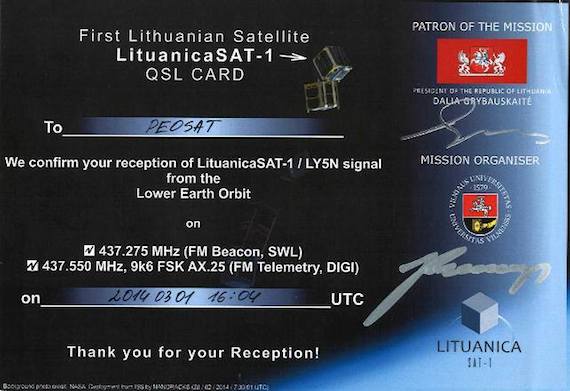Thanks LituanicaSAT-1 team for sending this QSL Card. Lets hope that this first launch is one of many to come.
Tomorrow AO-73 Continuous Transponder
Tomorrow 22-03-2014 there will be a FUNcube-1 (AO-73) Continuous Transponder Test.
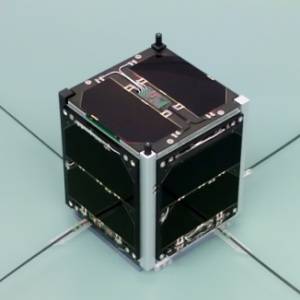 FUNcube-1 (AO-73) will be commanded into continuous transponder mode for one or two orbits so we can assess the effect of lower power being radiated by the sat on the battery temperature. We expect the satellite to be put into full time transponder mode (aka amateur mode) during the first morning pass on Saturday, March 22 over the UK, at approximately 0930 UTC.
FUNcube-1 (AO-73) will be commanded into continuous transponder mode for one or two orbits so we can assess the effect of lower power being radiated by the sat on the battery temperature. We expect the satellite to be put into full time transponder mode (aka amateur mode) during the first morning pass on Saturday, March 22 over the UK, at approximately 0930 UTC.
Please upload as many telemetry frames as possible so the group can analyze the effect on the battery.
Below the Orbitron pass prediction for Western Europe based on CEST (UTC+1)
Time zone : UTC +1:00
Search period : 03-22-2014 00:00:00 - 1 days
03-22-2014 24:00:00
Time Satellite Azm Elv Mag Range S.Azm S.Elv
--------------------------------------------------------------------------
03-22-2014 10:31:06 AO-73 90.8 20.1 ? 1406 138.6 31.5
03-22-2014 12:07:53 AO-73 289.9 50.9 ? 764 167.1 38.4
03-22-2014 13:43:20 AO-73 310.5 8.6 ? 2075 197.5 37.8
03-22-2014 19:58:15 AO-73 45.7 6.0 ? 2387 284.4 -10.1
03-22-2014 21:33:29 AO-73 65.6 34.0 ecl 1077 305.0 -23.5
03-22-2014 23:09:55 AO-73 263.9 34.1 ecl 1078 330.1 -33.6
The full article can be found at the Amsat-UK website: FUNcube continuous Transponder Test
Launch of 200 sprite Satellites
Launch of Two Hundred 437MHz Satellites
![]()
The largest ever launch of 437 MHz satellites is planned for March 16 at 0841 UTC when 200 Sprite satellites will fly on the SpaceX Falcon 9 CRS 3 mission to be deployed into a 325×315 km 51.5 degree inclination orbit. You should be able to watch the launch live on NASA TV.
![]() A Sprite is a tiny, 3.5 by 3.5 cm, single-board spacecraft that was developed by Zac Manchester KD2BHC. Among those involved in the early days of the project was UK radio amateur Michael Johnson M0MJJ. While a visiting scientist at Cornell University he was the first project manager designing the mission and KickStarter campaign.
A Sprite is a tiny, 3.5 by 3.5 cm, single-board spacecraft that was developed by Zac Manchester KD2BHC. Among those involved in the early days of the project was UK radio amateur Michael Johnson M0MJJ. While a visiting scientist at Cornell University he was the first project manager designing the mission and KickStarter campaign.
Each Sprite has a microcontroller, radio, and solar cells and is capable of carrying single-chip sensors, such as thermometers, magnetometers, gyroscopes, and accelerometers.
The 200 Sprites are carried in a 3U CubeSat called KickSat. They are stacked atop a spring-loaded pusher and secured by a nichrome burn wire system.
On reaching orbit KickSat will perform a de-tumble maneuver and establish communication with Cornell University’s ground station. After check-out, the spacecraft will be put in a sun-pointing attitude and spun up to maintain that attitude.
A command signal from the ground station will then trigger the deployment and the Sprites will be released as free-flying spacecraft. After deployment, telemetry and sensor measurements from the individual Sprites will be received through Cornell’s ground station in Ithaca, NY, as well as several other amateur ground stations around the world.
Due to the low orbit Sprites will have a short lifetime before they reenter the atmosphere and burn up. In the best-case scenario the orbital lifetime could be six weeks but realistically it may be considerably shorter depending on atmospheric conditions.
All Sprites operate on a single frequency of 437.240 MHz and use Code Division Multiple Access (CDMA). The transmitter runs 10 mW output of Minimum Shift Keying (MSK) modulated binary data with each data bit modulated as a 511 bit Pseudo-Random Number (PRN) sequence.
The ITU emission designator is 50K0G1D.
The KickSat CubeSat has downlinks on 437.505 MHz and 2401-2436.2 MHz.
Watch KickSat Sprite Deployment
KickSat Sprite Ground Station by Andy Thomas G0SFJ
http://kicksat.wordpress.com/support/kicksat-ground-station/
[PE0SAT Thanks Amsat-UK for the above information]
New launches
Thursday, February 27th, 2014 18:37 UTC
H2A rocket launch from Tanegashima Space Center with onboard the following satellites that will be operating in the Amateur radio frequency spectrum.
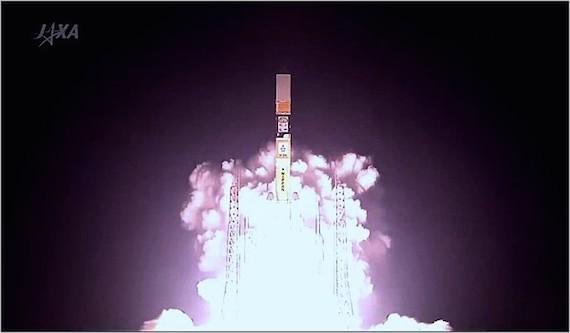
ShindaiSat active
STARS-II active
TeikyoSat-3 active
ITF-1 unknown
OPUSAT active
ARTSAT INVADER active

TLE
STARS-2 1 39573U 14009B 14060.87082916 .00126303 00000-0 14839-2 0 132 2 39573 065.0119 052.6783 0006119 332.8179 027.2647 15.60801074 327 TEIKYOSAT 1 39574U 14009C 14060.23330645 .00057725 00000-0 78972-3 0 105 2 39574 065.0209 054.8974 0013534 253.3290 106.6370 15.56980553 223 SHINDAISAT 1 39572U 14009A 14060.87351051 .00064061 00000-0 82319-3 0 120 2 39572 065.0127 052.6969 0012238 283.9608 076.0167 15.58639605 328 INVADER 1 39577U 14009F 14060.87113583 .00097025 00000-0 11575-2 0 144 2 39577 065.0140 052.6864 0006920 322.7443 037.3185 15.60509466 326 OPUSAT 1 39578U 14009G 14060.35832562 .00160311 00000-0 18885-2 0 109 2 39578 065.0126 054.4408 0005228 319.3305 040.7452 15.60613112 244 ITF-1 1 39579U 14009H 14060.23128098 .00085996 00000-0 10782-2 0 78 2 39579 065.0098 054.8826 0009000 291.4950 068.5241 15.59229553 221
Friday, February 28th, 2014 07:30 UTC
5 cubsats launched from the International Space Stations.
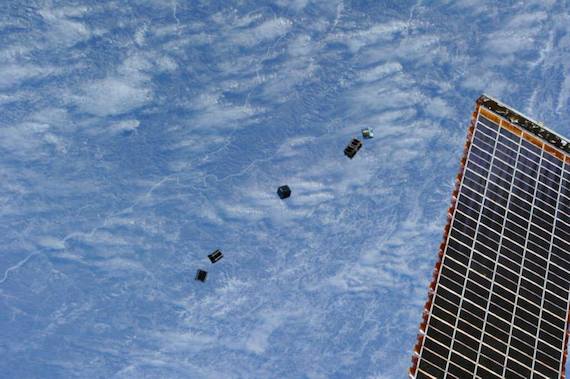
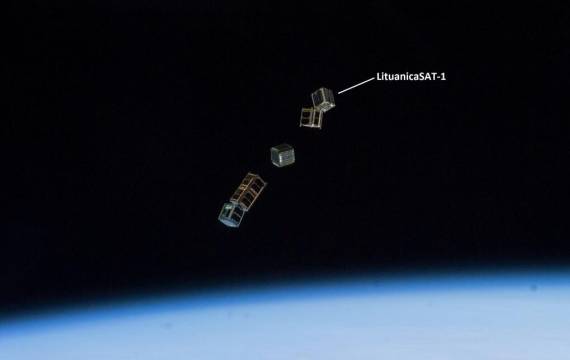
Feb 28, 2014 Cubesats deployment. Top to bottom: LituanicaSAT, LitSat, SkyCube, ArduSat-2, UAPSat
LituanicaSat-1 active
LitSat-1 active
UAPSat active
TLE
LITSAT 1 39568U 98067EM 14067.03574193 .00155139 00000-0 23417-2 0 243 2 39568 051.6475 240.8905 0005418 265.5665 191.9527 15.53686020 1182 LITUANICA 1 39569U 98067EN 14067.03763082 .00099761 00000-0 15624-2 0 295 2 39569 051.6475 240.9078 0005246 258.8855 198.5010 15.52907745 1189 UAPSAT 1 39571U 98067EQ 14066.92075337 .00066934 00000-0 10800-2 0 268 2 39571 051.6489 241.5135 0005261 235.8767 277.4092 15.52259356 1143
[PE0SAT Thanks DK3WN and Satellite Ground Stations for the above information]
Delfi-n3XT Some Bad News
Despite earlier messages there are no signals received from Delfi-n3Xt. It seems that the signals that where believed to be Delfi-n3XT where signals from Delfi-C3. Below a message I received from Jasper PC4JB.
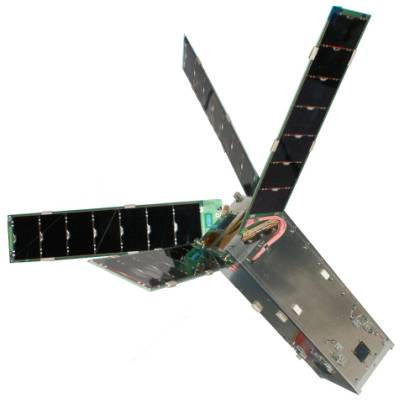 Unfortunately, we have not heard anything from Delfi-n3Xt since Thursday 20/02 after our transponder test. During the transponder test we could hear our side beacon at 145.870 MHz and we were still able to switch back to normal transmission an back to transponder again (and also received the beacon the second time). Nothing seemed to be wrong, except for the transponder itself not properly working. The satellite was supposed to return to nominal operations in the next orbit.
Unfortunately, we have not heard anything from Delfi-n3Xt since Thursday 20/02 after our transponder test. During the transponder test we could hear our side beacon at 145.870 MHz and we were still able to switch back to normal transmission an back to transponder again (and also received the beacon the second time). Nothing seemed to be wrong, except for the transponder itself not properly working. The satellite was supposed to return to nominal operations in the next orbit.
We think that a hardware failure occurred either at the second half of the transponder orbit or during the mode switch. Since Friday we have made many attempts to revive the satellite. Since we have an independent radio, there was (and still is some) hope to get the satellite back in transmission. There are however a few points were common mode failures could occur: the phasing circuitry which connects both transmitters and an I2C buffer at the main bus side. We do however still have some hope that only one radio has failed and that we might still be able to command the satellite to use the other. Since all trivial command schemes did not work, next week we will only focus on a specific test to turn the transmitter on for a brief moment. During the weekend we saw some narrow band signal at 10 kHz below 145.870 MHz (+/- Doppler), which might potentially be related to the local oscillator. If we can reconstruct this a few times and clearly correlate this to Delfi-n3Xt (we do have a lot of intermitting noises sources in the neighborhood) we at least know the OBC and one radio is still working and we can commence to next steps.
We appreciate everyone’s help to listen to Delfi-n3Xt to see if there is still some signal left. I think the best changes (besides Delft passes in which we try to command) are when the satellite comes just out of eclipse and is supposed to startup one of the transmitters. Please note that it has become very crowded with CubeSats lately, so any signals which are off in frequency (except for the -10 kHz tone), have a very different bandwidth and/or Doppler shift are very likely to be other satellites in the neighborhood. Today we had for instance Delfi-C3 almost perfectly aligned sending at the same frequency. Delfi-n3Xt will only transmit at about 145.870 MHz.
[PE0SAT Thanks Delfi-n3XT ground station for the above information]
Delfi-n3XT Transponder test
Coming, Delfi-n3XT Linear Transponder tests

We are going to test the transponder functionality of Delfi-n3Xt this week. I have to be honest that this functionality was implemented last minute on the satellite and was only tested briefly in a non-representative setup. I therefore estimate the chance that it will work at 50/50.
Our first series will be at:
- Thursday 20-02-2014 at about 10:50 UTC
- Friday 21-02-2014 at about 9:50 UTC
- Friday 21-02-2014 at about 11:25 UTC
After a few initial tests, and provided that it works, you are free to use the transponder for communication. We will leave it in this mode for the remainder of the sunlit part of the orbit, so only in Europe and Africa it is possible to use this mode for now. If successful we will turn on the transponder more often and for longer periods of time such that everyone can enjoy it.
Frequency:
Uplink 435.530 – 435.570 MHz LSB Linear transponder
Downlink 145.880 – 145.920 MHz USB Linear transponder (inverting)
DELFI-N3XT 1 39428U 13066N 14038.63217054 .00002453 00000-0 43939-3 0 699 2 39428 97.7772 111.8003 0129782 303.2748 55.6102 14.62338302 11392
Source: PC4JB, Jasper Bouwmeester, Delfi Nanosatellite Program Manager

